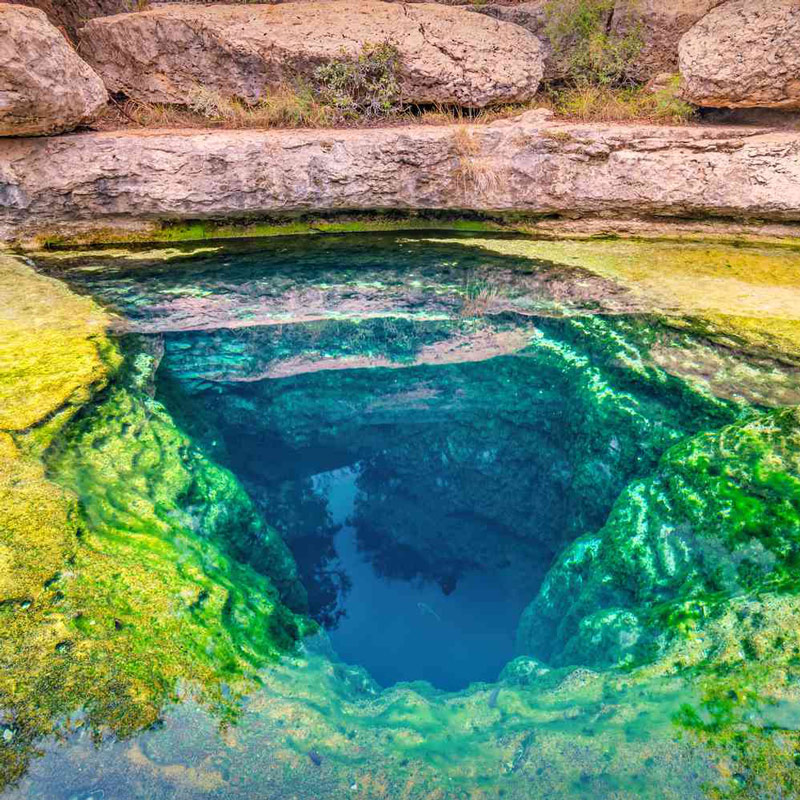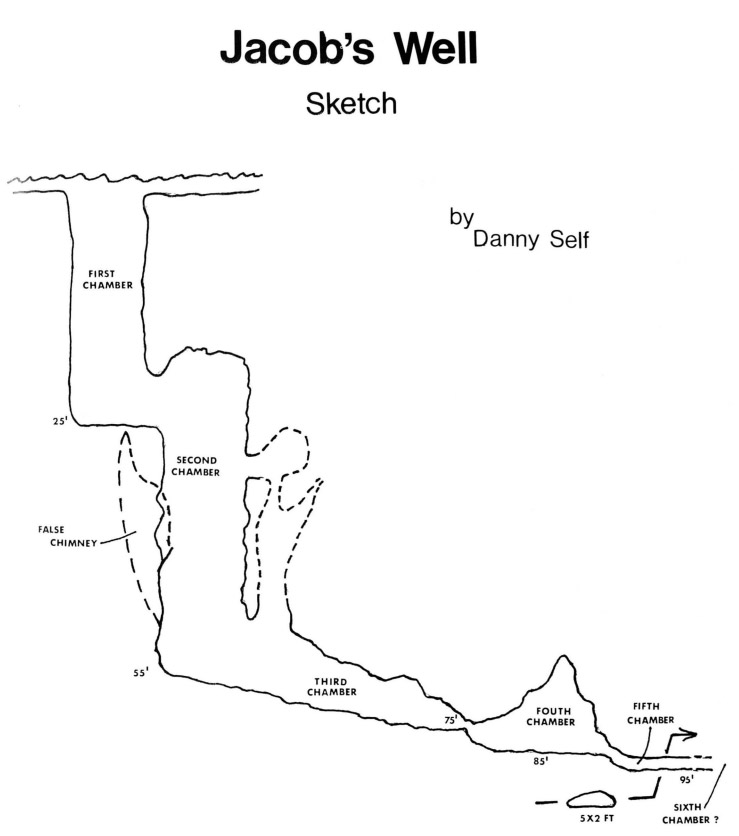Exploration and Tragedy at Jacob’s Well: John Wilcox, Danny Self, and Wayne Russell’s Dive Expedition


| Incident Location | Diver Names |
|---|---|
| Jacob’s Well, Wimberley, Texas | John Wilcox, Danny Self, Wayne Russell |
One would have thought that a cave with a Biblical connection would be harmless, unfortunately, it isn’t. Wayne Russell was diving with his friends in Jacob’s Well, and after a while, he signaled that it was time to go. With Wayne coming behind, on their way up, Wayne was nowhere to be found. Running low on air, they had to come up with a solution.
Despite its inviting appearance, the crystal-clear water in Jacob’s Well is quite dangerous. According to historical accounts, settlers came across the watering hole around 1850. It measures 12 feet in diameter and was spouting water up to five feet high when it was first discovered.
The settlers didn’t dive into the well but rather used it as a source of drinking water and even harnessed its power to operate a sawmill. The settlers named it Jacob’s Well, inspired by its biblical grandeur.
The temperature of the water stays constant year-round at 20 degrees Celsius, and since its discovery, explorers have explored at least 4,500 feet of the well. It is now considered to be the second-largest fully submerged cave in Texas, with an average depth of 120 feet and situated on 80 acres of protected land. Jacob’s Well receives its water from the Trinity Aquifer, which covers most of the southwestern region of the state. However, the fountain no longer discharges water at the rate of 170 gallons per second due to the development in the area and now only produces a slight ripple on the surface of the water. The water flows into Cypress Creek.
Exploring Jacob’s Well by diving can be risky as the passages are narrow, which necessitates removing the tanks. Even at the surface, Jacob’s Well can be dangerous as it is surrounded by rocks, and some people dive headfirst into it, performing flips and so on.
Wayne Russell, who started caving at the age of 15 in 1962, later joined the National Speleological Society. He dedicated himself to caving extensively in California, Texas, and Mexico, where he explored and mapped various water caves. Despite being a member of the NSS Cave Diving Section, he did not receive certification as a cave diver.
When he wasn’t exploring caves, Wayne worked as a mail carrier in Austin, Texas. His primary focus during his caving expeditions was mapping and cave photography. Furthermore, he played an active role in the speleological community, serving as Vice Chairman and Chairman of the Texas Speleological Association during the 1970s. Over the years, he also assisted in the formation of several caving clubs.
Exploring the Dangers of Jacob’s Well
On Sunday, February 26, 1984, three people entered Jacob’s Well: John Wilcox, Danny Self, and Wayne Russell. Both John and Danny were scuba diving instructors who worked independently, while Wayne was an experienced caver and cave diver. The trio was well-equipped, carrying a full wetsuit, a single 80 cubic foot tank, a single nose regulator with an octopus, depth and pressure gauge consoles, two to three lights each, and a spare 50 cubic foot tank. Due to the narrow passages, they did not have any buoyancy compensators.
They met at the first level in the first chamber, which was 25 feet deep, and then extended a safety line vertically from that point to the beginning of the third chamber, which was 55 feet deep. At a depth of about 85 feet, Wayne and John established a new safety line by running it horizontally through the third chamber and halfway into the fourth chamber. Then, Wayne led the way into the fifth chamber, passing through a narrow opening while pushing his tank in front of him and laying a new safety line. Meanwhile, John took pictures while following Wayne. Danny stayed back in the fourth chamber to maintain the safety lines and to search for an old tank left by two divers who drowned in the well in 1979 and were never found.
Once Wayne and John proceeded beyond the sixth chamber, Danny explored the fourth chamber, estimating it to be roughly 10 feet high by eight feet wide. After he finished, he retrieved some spare line, removed the tag, and squeezed through the passage. Once Danny was in the fourth chamber, he located the tank, attached a piece of line to it, and began to follow the safety line out. However, he was surprised to find that the fifth chamber was incredibly narrow, measuring only about two feet in height.
Furthermore, the visibility was deteriorating rapidly, causing Danny to feel increasingly anxious. Halfway out, he became entangled in the line he had tied to the old tank and was unable to proceed any further. After taking a deep breath, he managed to untangle himself and return to the fourth chamber. He then put his tank back on and attempted to pull the old tank through the opening.
Meanwhile, Wayne had tied his safety line halfway into the fifth chamber and had attached a survey tape, a 100-foot tape measure, that he would use to measure the length and diameter of the lower chambers. Wayne then ventured into the sixth chamber and beyond. John followed Wayne’s safety line and survey tape into the sixth chamber, where he took pictures. Due to poor visibility, John had difficulty taking pictures and seeing clearly.
Nevertheless, he got the impression that the sixth chamber was quite spacious and had a muddy bottom, unlike the rocky bottom of the other chambers. Wayne signaled to John that it was time to leave, so John followed the safety line back. However, when he reached the opening, he found that the old tank was stuck. After dislodging it, he pushed it while Danny pulled it through the opening. Then, Danny exited the fourth chamber with the old tank, while John exited the fifth, followed by Wayne.
The Third Chamber

Later, in the third chamber, Danny and John met up in the upper chamber. The visibility was slightly better compared to the lower chamber. Danny asked John about Wayne’s whereabouts, and John indicated down the tunnel, assuming that Wayne was either setting up his survey tape or fixing his tank. Until then, there was no indication of any problem, so they decided to ascend to a shallower depth to start decompressing, assuming Wayne would catch up. However, midway through their decompression stop, they started to get concerned. They couldn’t go back because they were low on air and had no bottom time. Eventually, they surfaced.
The next day, a dive team from Wimberley found Wayne lying on his safety line with his mask on and his tank by his side at the beginning of the fifth chamber. After Wayne’s death, his parents discovered a poem that he had written, which was read at his funeral on February 29, 1984. This friend of the earth and caving was buried near Utopia, Texas.
In 2015, when he was just 21 years old, Diego Adami decided to attempt a free dive into Jacob’s Well. Diego Adami is a highly accomplished freediver from Mexico. He was born in Mexico City and grew up near the ocean, where he developed a love for water sports. He began his freediving journey in 2010 and quickly became one of the most successful free divers in Mexico. Adami has achieved many impressive feats in the sport, setting several national records in various disciplines.
Diego captured the entire experience of his freedive in Jacob’s Well on camera. The footage shows Diego diving into Jacob’s Well without any supplementary air. He descends to the bottom of the first aperture, which is about 100 feet beneath the surface. However, during the dive, one of Diego’s flippers becomes detached from his foot, and he faces a significant challenge swimming back up to the surface without it. Despite these dangerous circumstances, Diego remains calm and quickly turns around.
The situation worsens when he accidentally drops his flashlight while pushing against the narrow walls of the cave, leaving him feeling vulnerable and scared. For a short second, he thinks about death and the possibility of dying that day. However, he maintains his composure, controls his breathing, and avoids using up his limited oxygen supply. He decides to cut off his supply belt to reduce weight and makes his way back to the surface as quickly as possible.
Despite the close call and the traumatic experience, Diego’s passion and excitement for perilous dives remain strong. He expresses that he has no plans to stop freediving anytime soon and even declares that he will be back in Jacob’s Well for more diving adventures later in the summer. It is evident that his love for the thrill of the dive overpowers his fear of danger, and he is willing to take risks to satisfy his adventurous spirit.
Jacob’s Well has proven to be a dangerous cave, with several casualties over the years. Only experienced cave divers should dive there. That’s why the Jacob’s Well Exploration Project (JWEP) was established. The authorities figured it was best to carry out the work of exploration through this group of professionals and reduce the casualties that occurred in the cave. At least nine people lost their lives while attempting to explore the cave system at Jacob’s Well.
The JWEP is the only organization authorized to explore the underwater caves at Jacob’s Well. The Hayes County Parks Department has granted the JWEP permission to conduct diving operations and research at Jacob’s Well. The project collaborates with various groups actively studying the site and has mapped all currently accessible passageways, totaling 6,000 feet.
The exploration efforts at Jacob’s Well began in the early 2000s with the involvement of the San Marcos Area Rescue Team (SMART) and the Wimberley Valley Watershed Association. Over time, the Jacob’s Well Exploration Project was formed, consisting of dedicated volunteers and experienced cave divers. Their self-funded efforts have resulted in the mapping and surveying of the entire cave system, providing valuable information for aquifer protection efforts.
FAQ
Yes, Jacob’s Well is a dangerous diving location due to its narrow passages, rocky surroundings, and limited visibility.
Jacob’s Well has an average depth of 120 feet.
Yes, the Jacob’s Well Exploration Project (JWEP) is the authorized organization for exploring the underwater caves at Jacob’s Well. They conduct diving operations and research to reduce the risk of casualties.
At least nine people have lost their lives while attempting to explore the cave system at Jacob’s Well.
Yes, the Jacob’s Well Exploration Project has mapped and surveyed all currently accessible passageways in the cave system, totaling 6,000 feet.
